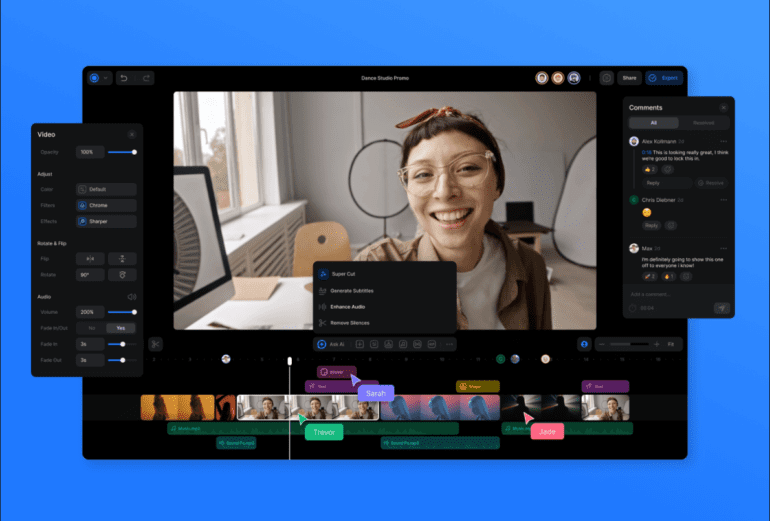TL;DR:
- Ozone, an AI-driven cloud-based video editor, raises $7.1 million in seed funding.
- The platform aims to speed up video editing tasks with AI, targeting content creators.
- Founded in 2021, Ozone’s AI assistant suggests actions during editing and offers real-time collaboration.
- Initially focusing on short-form content, Ozone plans to expand to longer content creation.
- Ozone aims to simplify video editing compared to complex tools like Adobe Premiere Pro.
- After the public launch, it will adopt a freemium business model with pricing starting at $29/month.
- Funding from Y Combinator, NEA, General Catalyst, and others.
Main AI News:
Ozone, the visionary behind an AI-driven collaborative video editing tool in the cloud, has successfully raised $7.1 million in seed funding and is now primed for an open beta launch. This Y Combinator graduate has set its sights on empowering content creators by leveraging AI to expedite laborious editing processes from hours to mere seconds. Ozone’s mission isn’t to replace human ingenuity with artificial intelligence; rather, it seeks to arm content creators with efficient tools that facilitate the creation of compelling videos at an unprecedented pace.
Founded in 2021 by Max von Wolff, Ozone boasts an in-house-developed AI assistant within its video editing platform, guiding users with actionable suggestions during the editing process. The software offers a robust suite of video editing features, unlimited cloud storage, and real-time collaboration capabilities reminiscent of Figma. Users can seamlessly perform tasks such as removing silences, adding captions and animations, color correction, and music integration, all with the indispensable assistance of AI.
Max von Wolff’s journey into cloud-based creativity software began during his time at MIT, where he was immersed in computer science and captivated by the possibilities of fostering creativity in the digital realm. His epiphany culminated in the decision to drop out and join Y Combinator. Ozone, his brainchild, now stands as the world’s inaugural collaborative and AI-fueled video editor, accessible right from your web browser.
Ozone’s formidable team comprises nine talented individuals, including engineers, designers, and a product manager, drawn from prestigious organizations such as Adobe, Frame.io, InVision, and Disney.
With Ozone, users can effortlessly upload their video footage and, with a simple click, apply a suite of AI functionalities to tasks that would otherwise be time-consuming to complete manually. For instance, users can swiftly eliminate awkward silences and instances of verbal hesitations like “um” or “uh.”
Initially targeting content marketers and creators producing short-form content for platforms like TikTok, Instagram, and YouTube, Ozone has grander ambitions. As the platform evolves, it aims to cater to creators producing longer content, including documentaries and films, by incorporating advanced editing capabilities.
Ozone’s vision extends beyond its competitors like Adobe Premiere Pro and Final Cut Pro, which, despite offering professional-grade editing features, are notoriously complex and lack collaboration options.
Max von Wolff emphasized, “If you look at the landscape, there is Adobe. They’ve been in the game for many decades, but their tools are extremely hard to use. They’re also disjointed, they’re all offline. You cannot collaborate in them. A lot of people are extremely frustrated with the solution that exists. And we really want to provide them with a tool that has the same, if not even more power, but with a level of simplicity that I think we haven’t seen before in the industry.”
Following its public launch, Ozone intends to adopt a freemium business model. Individual Pro users will gain access to the software for a monthly fee of $29, while enterprise pricing for companies has yet to be determined.
In terms of funding utilization, the startup will use the capital to expand its platform and introduce additional AI functionalities, slated to be rolled out in the coming months.
The funding round attracted investments from prominent backers, including Y Combinator, NEA, General Catalyst, LGVP, Bluewatch Ventures, Polymath Capital Partners, Pioneer Fund, SOMA Capital, Olive Tree Capital, and founders of renowned companies such as Dropbox, Tinder, and Lightricks.
Looking ahead, Max von Wolff envisions a bright future for Ozone. He stated, “In terms of the next ten years for Ozone, I really think that we’re only getting started serving a small part of the market here. We will add more features to our platform so that we can cover more industries and more use cases within our platform. On the AI side, I really think there will be further advancements that we can get to in a matter of one to two years that are going to be yet another step in terms of letting people create exactly what’s in their mind faster and to a high degree of quality.”
Conclusion:
Ozone’s successful funding round and innovative approach to AI-powered video editing represent a significant development in the market. It reflects the growing demand for user-friendly, collaborative, and AI-enhanced tools that can streamline content creation. As Ozone expands its capabilities and accessibility, it is poised to disrupt the video editing landscape, potentially posing a challenge to established players like Adobe. Content creators stand to benefit from more efficient and collaborative editing processes, making Ozone a key player to watch in the evolving content creation industry.

